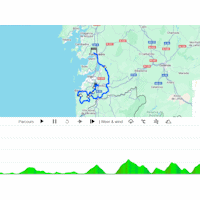The riders roll out from Poio, on Spain’s west coast, for a day of racing with barely a flat stretch in sight. The first 74 kilometres are relatively tame in terms of elevation changes, before the Alto de San Antoniño throws in 9 kilometres at an average of 4%. Upon cresting, the riders are nearly halfway through the stage.
The second half of the route is much more challenging. It begins with the Alto de Groba, an 11.5-kilometre climb averaging 5.4%. The steepest section lies in the opening 5 kilometres, which ascend 6.6%.
A rapid descent follows, punctuated by several short uphill kicks. The road then climbs out of the valley on a 3.2-kilometre stretch at a 6.9% gradient before a 7-kilometre descent leads to the base of the Alto de Prado. The riders crest the 5.6-kilometre ascent at 6.2% with just over 25 kilometres remaining.
Much of the remaining route goes downhill, but a 1.7-kilometre ramp at 6.4% serves up an intermediate challange. From there, the riders descen further to Mos, where they face the decisive ascent to Castro de Herville. The climb’s opening 3 kilometres, averaging 8.6%, deliver the hardest test of the day. The full 8.7 kilometres climb averages 5.1%.
La Vuelta last finished on the Alto Castro de Herville in 2021, where Clément Champoussin claimed the stage victory. However, the route to the summit was different on that occasion.
The Castro de Herville is a scenic viewpoint overlooking the Bay of Vigo. It belongs to the municipality of Mos, birthplace of Óscar Pereiro, the 2006 Tour de France winner following Floyd Landis’s disqualification.
Vuelta a España 2025 stage 16: route, profile, videos
Click on the images to zoom




